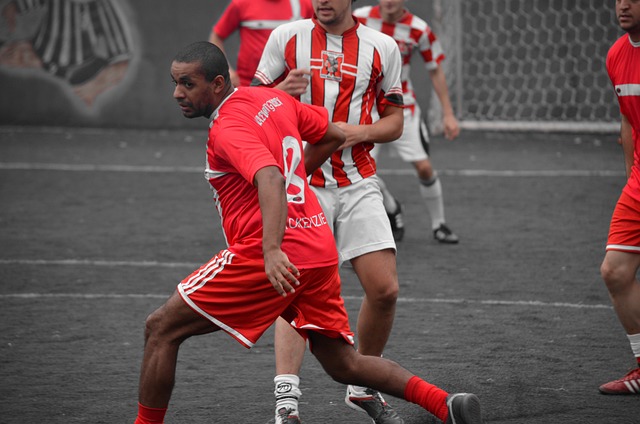Discover the mystery behind the blue card in soccer, an uncommon penalty that’s left fans puzzled. Get ready to learn something new!
Contents
- 1. Understanding the Symbolism: Decoding the Meaning of a Blue Card in Soccer
- 2. Unraveling the Uncommon: When and Why a Blue Card is Issued in Soccer
- 3. The Evolution of Soccer Penalties: How the Blue Card Became an Integral Part of the Game
- 4. Separating Fact from Fiction: Dispelling Common Myths about Blue Cards in Soccer
- 5. The Blue Card Penalty: What it Means for the Player and the Team
- 6. The Impact of a Blue Card: How it Affects the Game Dynamics and Strategy
- 7. Strategies for Avoiding Blue Card Offenses: Tips for Players, Coaches, and Referees
- 8. Dealing with Blue Card Situations: Smart Tactics for Players and Teams to Minimize Damage
- 9. The Role of Video Assistance: Enhancing Fairness and Accuracy in Blue Card Decisions
- 10. Global Perspectives: Comparing Blue Card Penalties in Different Soccer Associations
1. Understanding the Symbolism: Decoding the Meaning of a Blue Card in Soccer
In the world of soccer, there exist various colored cards that referees wield to indicate penalties and disciplinary actions during a match. While the yellow and red cards are widely recognized, the blue card remains a relatively uncommon sight on the field. Understanding the symbolism behind this unique card is crucial to unraveling its meaning.
A blue card in soccer primarily signifies that a player has committed a serious offense that warrants temporary removal from the game. Similar to a yellow card, it serves as a warning to the player, but with more severe consequences. When shown a blue card, the player is required to leave the field for a specified period of time, typically around five minutes, during which their team must play with a one-player disadvantage. This penalty aims to discourage dangerous or reckless behavior, allowing for a temporary recalibration of the match’s dynamics.
- Distinctive Identity: The blue card differentiates itself from the yellow and red cards, enabling the referee and spectators to identify the specific disciplinary action being taken.
- Short-Term Suspension: Unlike the red card, which leads to immediate expulsion, the blue card offers a temporary removal from the game, allowing the player an opportunity to rectify their behavior upon their return.
- Impact on Game Dynamics: The team with the penalized player faces the challenge of playing with a numerical disadvantage, making the blue card punishment a significant factor in influencing the outcome of the match.
While the blue card may not be as prevalent as its counterparts, its significance must not be overlooked. By better understanding the symbolism behind the blue card, players, fans, and officials can recognize the severe nature of certain offenses and appreciate the measures taken to maintain fair play and ensure the safety of everyone involved. So, the next time you witness a blue card being brandished on the soccer field, know that it represents a valuable tool in promoting sportsmanship and upholding the integrity of the game.

2. Unraveling the Uncommon: When and Why a Blue Card is Issued in Soccer
In the fast-paced world of soccer, penalties come in various colors, and one that often leaves fans perplexed is the elusive blue card. Generally associated with indoor soccer, this rarely seen card carries its own unique set of implications. While yellow and red cards are synonymous with caution and ejection, respectively, the blue card holds a distinct significance. Let’s delve into the intricacies of this uncommon penalty and understand when and why it is issued.
1. Accumulation of Fouls: One common scenario where a blue card may surface is when a player accumulates a certain number of fouls. Similar to the yellow card system, players are typically allowed a certain threshold of fouls before receiving a blue card. This serves as a warning to both the player and the team that further offenses will result in expulsion for a designated period of time.
2. Serious Misconduct: Occasionally, the referee may brandish a blue card for instances of severe unsporting behavior, not warranted of an immediate red card. These instances could include aggressive foul play, dissent towards officials, or intentional handballs denying a clear goal-scoring opportunity. The temporary removal through the blue card allows the game to continue while providing a clear indication that the misconduct will not be tolerated.

3. The Evolution of Soccer Penalties: How the Blue Card Became an Integral Part of the Game
Soccer penalties have witnessed a fascinating evolution throughout the years, and one such development that has left fans intrigued is the introduction of the blue card. This uncommon penalty has become an integral part of the game, allowing referees to enforce stricter punishment for certain offenses. So, what exactly does a blue card mean in soccer and how does it differ from the traditional yellow and red cards? Let’s delve into this intriguing aspect of the beautiful game.
Significance of the Blue Card:
The blue card is primarily used in indoor soccer or futsal matches, where the dynamics and rules differ slightly from traditional outdoor games. When a player commits a serious foul or misconduct, the referee may brandish a blue card, indicating their temporary expulsion from the game. This serves as a strict disciplinary measure and aims to prevent players from engaging in repeated or dangerous offenses.Penalty Duration:
Unlike a yellow card, which represents a caution, a blue card signifies a more severe penalty. The player receiving the blue card must leave the field for a specified amount of time, typically ranging from two to five minutes, depending on the competition rules. During this period, the penalized team is forced to play with one player less on the field, leading to a temporary advantage for the opposing team. Once the penalty duration elapses, the player can rejoin the game, but the infraction remains on the record.
In summary, the introduction of the blue card has brought a unique twist to the game of soccer, particularly in indoor matches. This less common penalty serves as a powerful tool for referees to maintain order and discourage serious fouls or misconduct. By understanding the significance and consequences of a blue card, players and fans alike can appreciate the evolving nature of soccer penalties and the efforts to make the game fair, safe, and enjoyable for everyone involved.
4. Separating Fact from Fiction: Dispelling Common Myths about Blue Cards in Soccer
Blue cards in soccer have long been a topic of confusion and misinformation. Many people believe that a blue card is a disciplinary action similar to a yellow or red card, but this is actually a myth. In reality, blue cards serve a completely different purpose in the game.
Blue cards indicate a time penalty: Contrary to popular belief, a blue card is not a warning or punishment for a player’s behavior on the field. Instead, it is used to signal a time penalty, during which the offending player must temporarily leave the field of play. This rule is most commonly seen in indoor soccer or futsal, where blue cards are employed to regulate the flow and intensity of the game.
Blue card offenses are typically minor infractions: Another common misconception is that blue cards are given for serious fouls or offenses. In truth, blue card offenses are generally less severe than those resulting in yellow or red cards. These infractions may include persistent fouling, dissent, or delay of game. While the specifics may vary depending on the league or competition, the purpose of the blue card remains consistent – to provide a brief period of player exclusion as a form of in-game punishment.
It is crucial for players, coaches, and fans to understand the true meaning and purpose of blue cards in soccer. By dispelling these common myths and clarifying the role of blue cards, we can ensure a more accurate understanding of the rules and a more enjoyable experience for everyone involved.
5. The Blue Card Penalty: What it Means for the Player and the Team
A blue card in soccer is a relatively uncommon penalty that can have significant consequences for both the player and the team. When a player receives a blue card, it is usually due to serious misconduct or flagrant violation of the rules. Unlike the more familiar yellow and red cards, the blue card is specific to indoor soccer or futsal matches.
One of the main implications of receiving a blue card is that the player is immediately removed from the field for a specified amount of time, typically around two minutes. This means that their team will be temporarily down a player, creating a numerical disadvantage that can significantly impact the team’s performance. During this time, the player must leave the field and cannot be substituted, leaving their team to play with fewer players on the pitch.
Additionally, a blue card can also result in a direct free kick awarded to the opposing team from the spot where the violation occurred. This can be a dangerous situation for the penalized team, as it grants the opposition an opportunity to create scoring chances or even score a goal directly from the free kick. The severity of the penalty depends on the nature of the misconduct, and in some cases, multiple blue cards can lead to more severe penalties, such as a red card and expulsion from the match. It is crucial for players and teams to understand the rules and consequences associated with the blue card to avoid costly mistakes during a game.
6. The Impact of a Blue Card: How it Affects the Game Dynamics and Strategy
A blue card is a penalty given in soccer that is relatively uncommon and often misunderstood. Unlike the yellow and red cards, which are more commonly seen and represent caution and expulsion, respectively, the blue card signifies a temporary exclusion from the game. When a player receives a blue card, they must leave the field for a specified period of time, usually around two minutes.
The blue card rule was introduced to soccer to address acts of unsporting behavior that do not warrant a red card but still require some form of punishment. It is typically shown for offenses such as dissent, simulation, or deliberate handball. Unlike a yellow card, which does not result in a player leaving the field, a blue card forces the team to play with one fewer player temporarily, impacting the game dynamics and strategy substantially.
- During the period of the blue card, the team with the penalized player is at a numerical disadvantage.
- The opposition team now has more space and freedom to move the ball, potentially creating opportunities for them to score.
- The team with the penalized player must adjust their formation and tactics, redistributing responsibilities among the remaining players in order to compensate for their disadvantage.
- Coaches often take advantage of this situation by implementing specific strategies to exploit the temporary weakness of their opponents.
In conclusion, the blue card holds a significant impact on soccer games, affecting the dynamics and strategy for both teams involved. It serves as a fair punishment for unsporting behavior, forcing teams to adapt and strategize under changing circumstances. Understanding the implications of this relatively uncommon penalty is crucial for players, coaches, and fans alike to comprehend the full complexity of the beautiful game.

7. Strategies for Avoiding Blue Card Offenses: Tips for Players, Coaches, and Referees
In soccer, a blue card is a penalty that is often misunderstood and frequently goes unnoticed. While yellow and red cards grab most of the attention, it’s important to understand the implications of a blue card offense and how to avoid it. Whether you’re a player, coach, or referee, here are some strategies to help you stay clear of this uncommon but impactful penalty:
- Stay vigilant: As a player, it’s crucial to always be aware of your surroundings and mindful of your actions. Avoid reckless challenges, especially those that endanger the safety of your opponents. Keep your temper in check and refrain from any unsportsmanlike conduct that could lead to a blue card.
- Communicate effectively: Good communication between players, coaches, and referees can prevent misunderstandings and reduce the risk of blue card offenses. Encourage your team to use clear and respectful language on the field, ensuring that everyone understands their roles and responsibilities. Coaches can play a significant role in promoting fair play and implore their players to compete within the bounds of the rules.
Remember, a blue card may result in a temporary suspension, forcing your team to play with a numerical disadvantage. By following these strategies, players, coaches, and referees can actively contribute to a more enjoyable and fair soccer experience for everyone involved. So, let’s stay informed, work together, and keep the blue cards at bay!

8. Dealing with Blue Card Situations: Smart Tactics for Players and Teams to Minimize Damage
Blue cards are a rare sight in soccer, but when they do come out, they can have a significant impact on the game. Unlike the well-known yellow and red cards, the blue card is unique to indoor soccer and signifies a more severe penalty. When a player receives a blue card, they are required to leave the field for a specified amount of time, usually around two minutes. During this time, their team must play short-handed, leaving them at a disadvantage.
To minimize the damage caused by a blue card situation, both players and teams must employ smart tactics. One effective approach is to quickly communicate and reorganize the team’s formation, ensuring proper coverage of defensive positions. This allows the team to maintain a solid defensive line and prevent the opposing team from taking advantage of the numerical superiority. Additionally, players should focus on playing a disciplined and cautious game, avoiding risky challenges or fouls that could result in further penalties. Keeping a cool head and staying focused on the game plan can help prevent the situation from escalating and minimize any harm caused by the blue card.
9. The Role of Video Assistance: Enhancing Fairness and Accuracy in Blue Card Decisions
In the world of soccer, a blue card is a relatively uncommon penalty that is used to enhance fairness and accuracy in decision-making. This penalty has gained prominence in recent years due to the introduction of video assistance technology, which aims to reduce human error and provide more accurate judgments on the field.
Video assistance plays a crucial role in blue card decisions by allowing match officials to review and analyze critical incidents during a game. With the help of multiple camera angles and slow-motion replays, referees can assess events that may have been missed or misinterpreted in real-time. This technology ensures that important decisions, such as issuing a blue card for serious fouls or misconduct, are based on clear evidence rather than subjective judgment. The use of video assistance not only enhances the fairness of the game but also holds players accountable for their actions, promoting a more respectful and sportsmanlike environment on the field.

10. Global Perspectives: Comparing Blue Card Penalties in Different Soccer Associations
In the world of soccer, penalties are a common occurrence on the field. However, there is one penalty that is relatively uncommon and often misunderstood – the blue card. While the yellow and red cards are widely known and used by soccer associations around the world, the blue card is a penalty that stands out due to its unique nature.
Different soccer associations have varying rules regarding blue card penalties. Let’s take a look at how some of these associations handle this peculiar penalty:
- United States Indoor Soccer Association (USISA):
- The blue card is exclusively used in indoor soccer matches.
- When a player receives a blue card, they are sent off the field for a period of two minutes, leaving their team a player short for that duration.
- The penalized team must play with four outfield players instead of the standard five until the two-minute penalty expires.
- Beach Soccer Worldwide (BSWW):
- Blue cards are a part of the penalty system in beach soccer.
- A player receiving a blue card must leave the field for a period of two minutes, leaving their team with fewer players temporarily.
- However, unlike in indoor soccer, the penalized team is not required to play with fewer players. They can replace the sent-off player immediately, maintaining an equal number of players on the field.
Understanding the variations in how blue card penalties are applied in different soccer associations gives us a global perspective on this uncommon penalty. Whether it’s indoor or beach soccer, the blue card adds a unique twist to the game and serves as a reminder that there’s always something new to learn in the world of soccer.
In conclusion, the blue card in soccer is a rare penalty used to punish serious offenses. It signifies temporary removal from the game and shows the referee’s determination to maintain fair play. Remember, this uncommon card carries significant consequences. Stay informed and play by the rules!
![How Long is a Soccer Game? [Pro/College/HighSchool/Youth] 11 how long is a soccer game?](https://stmichaelssoccer.com/wp-content/uploads/2022/10/how-long-is-a-soccer-game-150x150.jpg)


